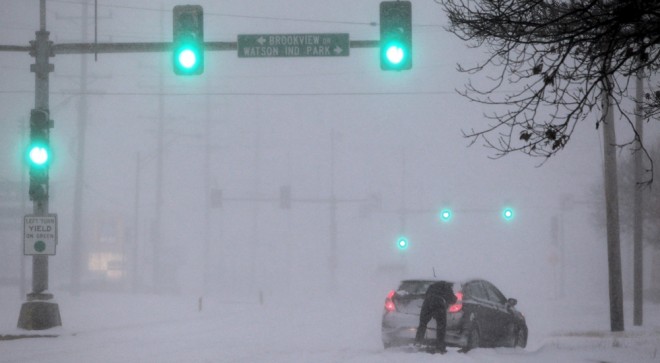Below-zero temps push into US Midwest, Northeast

A Crestwood motorist tries to get his car moving along Watson Road in St. Louis as heavy snow falls on Sunday, Jan. 5, 2014. Snow-covered roads, high winds and ice were creating dangerous driving conditions from Missouri to Delaware on Sunday ahead of a “polar vortex” that’ll bring below-zero temperatures not seen in years to much of the nation in the coming days, likely setting records. AP
CHICAGO – Icy, snow-covered roads and high winds made travel treacherous Sunday from the Dakotas to Michigan and Missouri as much of the U.S. braced for dangerously cold temperatures that could break records.
A whirlpool of frigid, dense air known as a “polar vortex” was expected to suppress temperatures in more than half of the continental U.S. starting into Monday and Tuesday, with wind chill warnings stretching from Montana to Alabama.
The forecast is extreme: 25 below zero Fahrenheit (31 below zero Celsius) in Fargo, North Dakota, minus 31 F (minus 35 C) in International Falls, Minnesota, and 15 below F (26 below C) in Indianapolis and Chicago. Wind chills — what it feels like outside when high winds are factored into the temperature — could drop into the negative 50s and 60s. Northeastern Montana was warned Sunday of wind chills up to 59 below zero F (51 below zero C).
“It’s just a dangerous cold,” National Weather Service meteorologist Butch Dye in Missouri said.
Several Midwestern states received up to a foot (30 centimeters) of new snow Sunday. The National Weather Service said snowfall at O’Hare International Airport in Chicago totaled more than 11 inches (28 centimeters) as of 6 p.m. Sunday — the most since the Feb. 2, 2011, storm.
Article continues after this advertisementIn Chicago, temperatures were expected to bottom out around minus 15 F (minus 26 C) overnight, likely setting a daily record, National Weather Service meteorologist Ed Fenelon said. Earlier Sunday, temperatures sank to 20-below F (29-below C) and colder in northern Minnesota and Grand Forks, North Dakota.
Article continues after this advertisementThe deep freeze extended into Canada where parts of eastern Alberta and northwest Ontario were under wind chill warnings. In Winnipeg, Manitoba, temperatures fell to minus 22 F (minus 30 C) on Sunday.
It hasn’t been this cold for almost two decades in many parts of the U.S. Frostbite and hypothermia can set in quickly at 15 to 30 below zero F (26 to 34.4 below zero C).
Travel problems started early Sunday. In New York City, a plane from Toronto landed at Kennedy International Airport and then slid into snow on a taxiway. No one was hurt, though the airport temporarily suspended operations because of icy runways.
About 1,300 flights had been cancelled Sunday at O’Hare and Midway international airports in Chicago, aviation officials said, and there also were cancellations at Logan International Airport in Boston and Tennessee’s Memphis and Nashville international airports.
School was called off Monday for the entire state of Minnesota, as well as cities and districts in Wisconsin, Illinois, Indiana and Iowa, among others.
Chicago Public School officials also cancelled classes for Monday ahead of the expected bitterly cold temperatures.
Southern states were bracing for possible record cold temperatures, too, with single-digit F highs (highs from minus 13 to minus 17 C) expected Tuesday in Georgia and Alabama.
Temperatures are expected to dip into the 30s F (single digits C) in parts of Florida on Tuesday. But Florida Citrus Mutual spokesman Andrew Meadows said it must be at 28 degrees F (minus 2 C) or lower four hours straight for fruit to freeze badly.